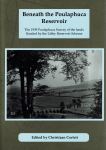Twelfth Collection of Articles on West Wicklow History
Full title: Journal of the West Wicklow Historical Society: Number 12, 2023-24
Creator / Author: West Wicklow Historical Society & contributors, joint editors Chris Lawlor, Declan Keenan
Item Type / Page count: Journal (Complete issue) / 200p
When Published: 2023
Publisher / Place of Publication: West Wicklow Historical Society / Baltinglass (?), Co. Wicklow.
About: This twelveth publication of this biennial journal was launched in the Coimín Centre, Blessington on 9/11/2023. It includes perhaps the most diverse set of topics yet to appear in this journal. Full contents are listed below. The most extensive article in this issue runs to 24 pages. In it, Peter W. Halligan provides an enlightening account of the castles at Oldcourt and Three Castles.
ID number(s): 0790-1739
Contents: Foreword from the Chairman / Paul Gorry — Donal McDonnell (1945-2022) — Secretary’s Synopsis / Cora Crampton — Noel Lyons (1942-2022) — Editor’s Preface / Chris Lawlor — Mapping the devolved Gaelic territories and districts of the O’Tooles / Declan Keenan — Migrant railway workers and local communities: a case study of Harristown station on the Sallins-Tullow branch line 1883-1951 / John O’Brien — Some observations on the Great famine in County Wicklow, c.1845-1850 / Gerald Cullen — Gentry, Brides and Lions / Maura Murphy Gibson — The man who wore a blue shirt in 1933: the Bass War in West Wicklow and Kildare / Declan O’Connor — A little bit of Bulgaria in Ireland: Pierce O’Mahony (1850-1930): politician and philanthropist / Brian McCabe — Dame Ninette de Valois (Edris Stannus) / Paul Tyrell — A 1792 Rental of the Lordship of Belan, Co. Kildare / Richard B. Lennon —Language Matters Revisited / Ita Roddy — Death from a Flat-Nosed Bullet in Blessington / James Scannell — A farming community: Hollywood in the early twentieth century / John Glennon — Sadhbh O’Byrne – glimpses of a Gaelic woman of sixteenth-century Ireland / Cora Crampton — The Manor of Blessington, created by Michael Boyle / Jim Corley — Revisiting the 1798 Dunlavin massacre for its 225th anniversary / Chris Lawlor — Balfe the Robber / Brendan Corrigan — A sociological interpretation of the Hillfort Capital – exploring Hughstown and Tinoran hillforts (part 1 of 3) / Mairéad Kelly — Charles Maule Drury (1848-1939) – collector of folklore / Paul Gorry — The castles of Oldcourt and Three Castles / Peter W. Halligan — ‘I say it as I think it’ : The life and controversial times of Rev. T. C. O’Connor, Rector of Donoughmore and Donard / Rosemary Raughter — Query / Peter W. Halligan.
Extra #1: Illustrated throughout with black & white photographs and maps.
Extra #2: Check Libraries Ireland for this publication.
Extra #3: Check OCLC WorldCat.org for this publication in libraries worldwide
Extra #4: Visit the West Wicklow Historical Society website









